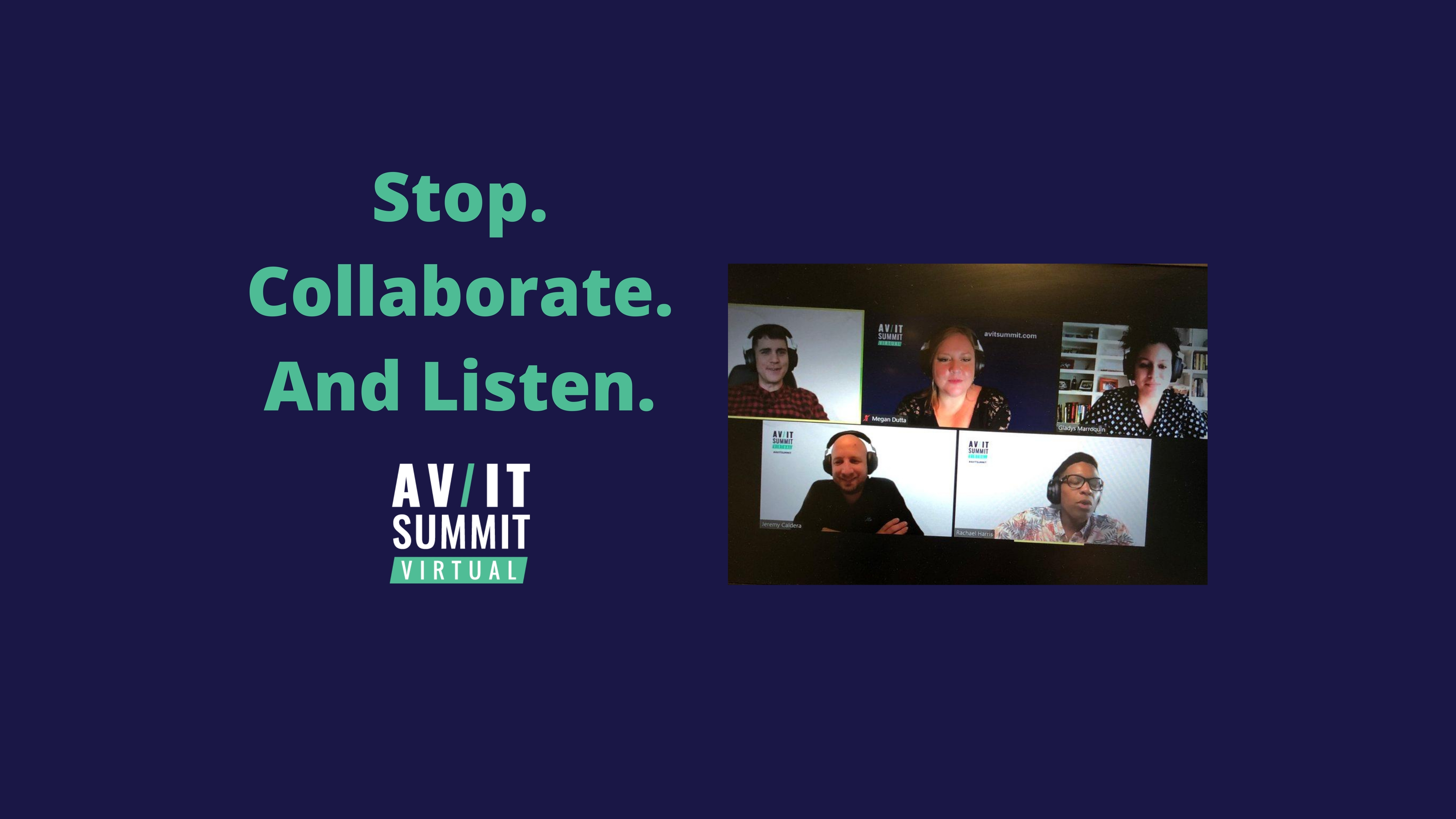'Stop. Collaborate. And Listen' at the 2020 AV/IT Summit

One of the hallmarks of the AV/IT Summit each year is the uniting of integrators, consultants, and end users in a discussion of how we can better collaborate to create better outcomes for our customers. It’s an allying of the audiences of the two organizing publications, AV Technology and Systems Contractor News, and the result is a frank dialogue that inspires change.
This year’s edition, titled “Stop. Collaborate. And Listen,” was no different. Featuring Jeremy Caldera, CTS-D, CTS-I of IAS Technology, Joe Dunbar of Diversified, Rachael Harris of a large financial institution, and Gladys Marroquin of Newcomb & Boyd, the panel, which was moderated by SCN’s Megan Dutta, tackled a variety of timely topics revolving around the general subject of achieving better teamwork.
Talking to the Right People
Rachael Harris hit upon the theme for the entire discussion at the outset: “Communication is the key to everything,” she said, outlining the importance of dialog not only between various parties, but within organizations as well.
This latter point was echoed by Joe Dunbar, who observed that oftentimes stakeholders in an organization and the actual users of the technology won’t be on the same page during the planning process. “There’s always been a gap between those two groups,” he said. “I always think about how we can better supplement their interactions and conversations, because a lot of the time that conversation doesn’t happen, and that feedback isn’t flowing.”

This panel and all the others that took place during the AV/IT Summit are available online.
Jeremy Caldera agreed: “I think we’re talking to the right people, then when it comes time to do the training, the end users say ‘This isn’t what I wanted.’ As an integrator, it’s hard to fix that breakdown.”
Harris suggested the importance of brining the actual users in the design phase, “because real end users aren’t ‘end users;’ the real end users are [employees like] accountants,” she said. “Those people are the ones who need to be more involved in the process.”
Caldera offered that a well-defined scope of work with a detailed “10,000-foot-view” executive summary can be helpful for getting as many people on the client side informed of what the project entails.
A daily selection of features, industry news, and analysis for AV/IT professionals. Sign up below.
Staying on Time
Gladys Marroquin shared that the biggest point of friction she has when working with integrators as a consultant is timelines. “At the end phase, when we try to close out and verify a system, the timeline of integrators saying a system is going to be ready is almost always inaccurate,” she said. “When they say systems are ready for day-one use, it’s almost never the case.”
Dunbar suggested that this can be the result of small things the integration team may have missed—something that regular dialog can help prevent. “Every one of us knows when you look at these documents, and you read through plans, and you read specifications, after the third our fourth time around, it’s like ‘I need to remove myself from this; I need to take a break, because I can only count TVs so many times,’” he said. “Delivery to consultant could be a pretty easy thing to build into the workflow, to help catch things that got missed.”
Watch another panel from the 2020 AV/IT Summit: "The Future of Pro AV" with Martin Bodley of Bose, Clint Hoffman of Kramer, Vanessa Jensen of Shure, Rich Ventura of Sony Electronics and Jason Vossler of Dell Technologies.
Another breakdown in the integrator-consultant dynamic is changing scopes of work, according to Caldera. “Sometimes when the consultant started the project, they were specifying equipment that’s now two years old,” he said. “They were dealing with a scope of work that is old, and now people have changed, users have changed, needs of changed. Having that communication and approval process is the most important thing.”
A Seat at the Table
Overall, though, the panelists agreed that communication among all parties in a project—including architects, IT, and building systems—is improving, especially now that AV has gone from a “nice-to-have” to a “must-have” solution because of the pandemic. “AV hasn’t had the same seat at the table as some of the other trades have, but it’s getting better,” Caldera said. “We’ve been learning the language, and for the end users’ sake, us finding a way to communicate better is going to be helpful.”
All of the 2020 AV/IT Summit content—including the exhibit hall—is available on demand for the next month. To learn more, visit avitsummit.com.
Matt Pruznick is the former editor of AV Technology, and senior editor for Systems Contractor News and Residential Systems. He is based in New York.

